Kapisa Province
Kapisa (Pashto/Persian: کاپيسا) is one of the 34 provinces of Afghanistan. Located in the north-east of the country. The population of Kapisa is estimated to be 364,900, although there has never been an official estimate. The province covers an area of 1,842 km2 making it the smallest province in the country, however it is the most densely populated province apart from Kabul Province.[2] It borders Panjshir Province to the north, Laghman Province to the east, Kabul Province to the south and Parwan Province to the west. Mahmud-i-Raqi is the provincial capital, while the most populous city and district of Kapisa is Nijrab.
Kapisa
کاپیسا | |
|---|---|
 | |
 Map of Afghanistan with Kapisa highlighted | |
| Coordinates (Capital): 35.0°N 69.7°E | |
| Country | |
| Capital | Mahmud-i-Raqi |
| Largest city | Nijrab |
| Government | |
| • Governor | Syed Mohammad Khalid Hashimi |
| • Deputy Governor | Mohammad Nabi Safi |
| Area | |
| • Total | 1,842.1 km2 (711.2 sq mi) |
| Population (2015)[1] | |
| • Total | 441,010 |
| • Density | 240/km2 (620/sq mi) |
| Time zone | UTC+4:30 (Afghanistan Time) |
| ISO 3166 code | AF-KAP |
| Main languages | Pashto, Persian and Pashayi |
History
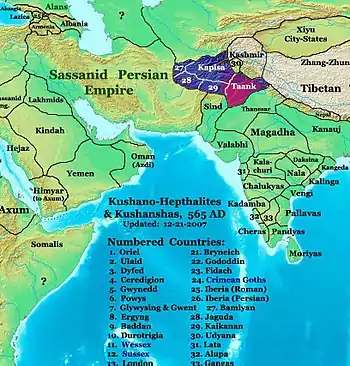
The earliest references to Kapisa appear in the writings of fifth century BCE Indian scholar Pāṇini. Pāṇini refers to the city of Kapiśi, a city of the Kapisa kingdom,[3] modern Bagram.[4] Pāṇini also refers to Kapiśayana,[5] a famous wine from Kapisa.[6] The city of Kapiśi also appeared as Kaviśiye on Graeco-Indian coins of Apollodotus I and Eucratides.[7]
Archeological discoveries in 1939 confirmed that the city of Kapisa was an emporium for Kapiśayana wine, bringing to light numerous glass flasks, fish-shaped wine jars, and drinking cups typical of the wine trade of the era.[8] The grapes (Kapiśayani Draksha) and wine (Kapiśayani Madhu) of the area are referred to in several works of ancient Indian literature.[9] The epic Mahabharata also mentions the common practice of slavery in the city.[10]
Based on the account of the Chinese pilgrim Xuanzang, who visited in AD 644, it seems that in later times Kapisa was part of a kingdom ruled by a Buddhist kshatriya king holding sway over ten neighboring states, including Lampaka, Nagarahara, Gandhara, and Banu.[11] Xuanzang notes the Shen breed of horses from the area, and also notes the production of many types of cereals and fruits, as well as a scented root called Yu-kin.
Kapisa province under the Mauryan Empire rule
The Kapisa province territory fell to the Maurya Empire, which was led by Chandragupta Maurya. The Mauryas introduced Hinduism and Buddhism to the region, and were planning to capture more territory of Central Asia until they faced local Greco-Bactrian forces. Seleucus is said to have reached a peace treaty with Chandragupta by giving control of the territory south of the Hindu Kush to the Mauryas upon intermarriage and 500 elephants.
Alexander took these away from the Aryans and established settlements of his own, but Seleucus Nicator gave them to Sandrocottus (Chandragupta), upon terms of intermarriage and of receiving in exchange 500 elephants.[12]
— Strabo, 64 BCE – 24 CE
Some time after, as he was going to war with the generals of Alexander, a wild elephant of great bulk presented itself before him of its own accord, and, as if tamed down to gentleness, took him on its back, and became his guide in the war, and conspicuous in fields of battle. Sandrocottus, having thus acquired a throne, was in possession of India, when Seleucus was laying the foundations of his future greatness; who, after making a league with him, and settling his affairs in the east, proceeded to join in the war against Antigonus. As soon as the forces, therefore, of all the confederates were united, a battle was fought, in which Antigonus was slain, and his son Demetrius put to flight.[13]
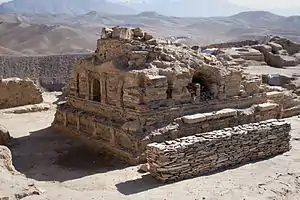
Having consolidated power in the northwest, Chandragupta pushed east towards the Nanda Empire. Afghanistan's significant ancient tangible and intangible Buddhist heritage is recorded through wide-ranging archeological finds, including religious and artistic remnants. Buddhist doctrines are reported to have reached as far as Balkh even during the life of the Buddha (563 BCE to 483 BCE), as recorded by Xuanzang.
In this context a legend recorded by Xuanzang refers to the first two lay disciples of Buddha, Trapusa and Bhallika responsible for introducing Buddhism in that country. Originally these two were merchants of the kingdom of Balhika, as the name Bhalluka or Bhallika probably suggests the association of one with that country. They had gone to India for trade and had happened to be at Bodhgaya when the Buddha had just attained enlightenment.[14]
Just like the rest of Afghanistan, many historical sites in Kapisa have been looted by smugglers and then sold abroad. During 2009 and 2010 twenty-seven relics were discovered by the National Security forces; these included ancient relics belonging to 2 BC and 4 BC mostly from Kohistan district.[15] It was part of Delhi Sultanate, Khilji dynasty in particular.
French-US involvement

France's experience in Afghanistan has mirrored every other country's misadventures in this Central Asian state; some small successes followed by some pretty devastating defeats. Initially, the French involvement in Afghanistan was limited to the International Security Assistance Force (ISAF) mission in Kabul;[16] as that mission expanded to encompass the entire country, France slowly amped up its involvement. By 2008, France had sole responsibility for Kapisa, and a district of Kabul Province that borders it. The French mission in Afghanistan has been fraught with struggle. The French military has fought very hard in Afghanistan and lost a lot of soldiers in the process: 87 since 2008 (many argue that there were more fatalities), behind only the U.S., Canada, and the UK. Yet, the newly elected French President François Hollande announced that French troops would withdraw from Afghanistan by the end of 2012– sparking speculation about whether this indicated the NATO coalition there is starting to crumble.[17]

Prior to 2012, French forces were complemented by U.S. forces through Provincial Reconstruction Teams and Human Terrain Teams. The province was served by the Kapisa PRT, located at Forward Operating Base Morales-Frazier in Nijrab District.[18] The PRT conducted counterinsurgency and stability operations in the province for more than six years, working with leaders of Kapisa at the provincial and district level, to bolster the capacity and credibility of the Government of the Islamic Republic of Afghanistan. The PRT participated in key leader engagements, scouting areas for new projects and performing quality checks and site visits on existing projects. The key focus is on building roads, bridges, construction of schools and also improvements to power capabilities on existing infrastructure.[19] Composed of U.S. Air Force, Army, State Department, and USAID subject matter experts and mentors, the team sought to work closely with key leaders to facilitate development. The vision was to foster a stable and secure environment ready for transition to the Government of the Islamic Republic of Afghanistan control and administration, and focus on sustainment.
Increased coalition presence
By August 2008 the French mission was facing serious challenges. A shocking ambush in Surobi, the district of Kabul Province they were responsible for patrolling, killed 10 French troops.[20] The Surobi massacre spurred a larger debate in France about the war. After taking over from the U.S., which exercised partial control over the province for several years beforehand, the French continued to follow the U.S.-led approach of sending troops through an area to kill or chase away militants. Like the American military, the French never developed a solid plan for consolidating their victories and building on successes – which left many areas of Kapisa in a constant tug-of-war between the French and the insurgents.[21]
In early 2009, French forces embarked on a significant campaign which aimed to retake an eastern Alasay District that the Taliban has controlled for the previous year. Alasay district is a strategic goldmine: it lies along a primary infiltration route into and out of Pakistan, it provides easy access to Kabul in an easily defensible primary valley (there are two other valleys in Alasay District), and it is mostly populated by the ethnic minority the Pashai and some Nuristani. In a French-led NATO force initiated, the operation was a success initially, due to reaching out to locals beforehand, they retook the entire valley with a single casualty over a single day of fighting.[22] Almost immediately, the Afghans of the valley welcomed the French, and things seemed to be looking up. However, they didn't stay. Much as in previous efforts to "sweep" the province, the French were dragged into other tasks, like protecting the main highway that travels the province from north to south through the volatile Tagab Valley. As a result, Alasay fell back to Taliban later that year and the security situation in the province deteriorated. It was that same tug-of-war all over again, with the residents of Alasay left frustrated and less safe than ever before. As 2009 progressed, bigger and bigger chunks of the province came under the sway of the insurgency, leading the provincial capital being more or less under curfew from the militants. By 2010, the French had stopped liaising with their Afghan Army counterparts, and the Provincial Reconstruction Team had ceased most of its operations.[23]
In late 2009, the province saw an influx of ISAF forces as the French elevated their presence from a Battalion-strength Task Force under Task Force Korrigan (Groupement tactique interarmes de Kapisa) to a Brigade-strength Task Force under Task Force Lafayette (Brigade La Fayette). At the same time, the Kapisa PRT, formerly the Parwan-Kapisa PRT, relocated from Bagram Airbase to FOB Morales-Frazier, focusing exclusively on operations in the Kapisa Province for the following three years.
Addressing provincial corruption
The French military's growing frustration with their inability to make progress resulted in tensions with the Afghans they were meant to support. These tensions stemmed in large part from the challenge of the overall ISAF missions to build support for the legitimate government of Afghanistan with the realities of the dysfunctional local government within Kapisa. The provincial governor, Ghulam Qawis Abubaker, was widely viewed as corrupt and was accused by contractors and district officials of funding insurgent elements in order to keep Kapisa unstable enough to keep PRT dollars coming into the province at higher levels, which in turn would widen the corruption problem. In 2010, the governor himself would be removed and charged by ISAF with corruption, though the Karzai administration would later refuse to prosecute the case.[24] U.S. forces, to include the PRT, also believed the Governor himself was responsible for the killing of the Panjsher PRT Commander in May 2009 (believing the Kapisa PRT commander to be the true objective) and of escalating attacks in northern Kapsia in Fall 2009 aimed at both PRT and French convoys as the counterinsurgency effort during this period shifted to Tagab and Alasay.[25]
For much of the period leading up to this, the French forces, ISAF, and the U.S. PRT differed in strategies for dealing with the problem and whom to deal with among the Afghan population, eventually seeking out district-level shura approaches to fund projects at the community level and alleviate the concerns villagers had with existing projects and bypassing the provincial leadership.[26] This strategy continued to gain support across the coalition elements as provincial officials were being arrested[27] for having ties to the insurgency.[28]
French withdrawal
When a bombing took place in central district of Nijrab killed four French soldiers in June 2012,[29] within France the bombing resonated deeply: while President Hollande had before indicated that he might keep some French troops in the country to help with the training mission, he later announced a full withdrawal by July. France being the fifth largest contributor to NATO's ISAF coalition, with nearly 3,300 soldiers, began its troop withdrawal from Afghanistan in July and completed it by the end of the 2012. Kapisa transitioned to Afghan control in the third of a five-phase transfers. Withdrawing French troops by the end of 2012 had been one of Mr Hollande's election pledges. The date meant that French forces left the country two years before the main scheduled NATO pullout.[30]
The early French withdrawal has led some to speculate that Kapisa will become a security vacuum just outside Kabul. This would be no small matter: the "ring of steel" that surrounds Afghanistan's capital has been broken[31] so many times that few have faith in the capital's safety anymore. Several of those early attacks, before the influx of French troops, were planned and supported out of the Tagab Valley. The French presence there had reduced the ability of militants in Kapisa to launch attacks into Kabul. When the French leave, the U.S. would not have the troops to fill in the gap, leaving a big opportunity for militants north of Kabul to strike back. Most of the province population believe that the long-term presence of foreign forces in Afghanistan can only serve to perpetuate the war cycle and the departure of the French will weaken the Taliban stance.[32] Over 60 French soldiers have been killed in Kapisa since 2008, with hundreds more injured severely. With the help of Afghan National Army, French forces conducted operations to repel the insurgents and Afghan forces were able to gain a foothold in Kapisa valleys. They oversaw the formation of the 3rd Brigade of the 201st Afghan corps that is now deployed in Kapisa and of the Afghan police who now are solely responsible for providing the province's security.
A transition ceremony for Kapisa Province was held July 4, 2012, formalizing the symbolic transfer of responsibility of the province from ISAF to Afghan authorities as part of the transition process in the province launched May 13, 2012; the Afghan security forces began to take the lead since autumn 2011. However the insurgency remains active in Tagab and Alasay districts.[33]
Geography
Kapisa province is located 80 km north east of Kabul a stark mountain moonscape that for centuries was home to gunmen who preyed on travelers and harassed invaders in the narrow mountain passes. As recently ambushes of NATO troops were not uncommon. It is bordered from the north by Panjshir Province, from the east by Laghman Province, from the south by Kabul province and from the south west by Parwan province. The province covers an area of 1,842 km2; that makes it the smallest province in all of Afghanistan. Kapisa Province's terrain is a mixture of high peaks, mountainous river valleys, and shallow central plains; the highest points of the province are in the east, on the borders with Panjsher and Laghman Provinces.[34] The province is a strategic crescent that was fought over by many invaders since dawn of time and as recently as the British in the 19th century, the Russians in the 20th century and now the NATO coalition.
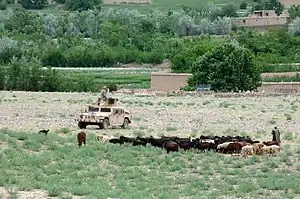
Politics and security
.jpg.webp)
The districts of Kohistan, Mahmud Raqi, and Kohband districts, all of which are Jamiat-i Islami and almost all Tajik, have become targeted zones of interest for the insurgency. Because they are close enough to Kabul, the militants count attacks there as attacks in Kabul. Whilst the districts of Tagab, Alasay and Nijrab are Hizb-i Islami Gulbuddin supporters and are a mixture of Pashtuns, Tajiks and Pashai. The importance of Kapisa comes as it lies along the approach to the Panjshir River valley and most of the major Jamiat figures have managed to secure wealth and power in the post-2001 Afghanistan, while most of the HiG figures have not. As a result, most of the violence in the area is not actually "Taliban" as we would normally consider it, but HiG fighters (and in a lot of cases petty thugs) calling themselves Taliban.
In July 2007 Abdul Sattar Murad, was removed from office by President Hamid Karzai, and his replacement was Ghulam Qawis Abubaker. The ostensible reason for Murad's removal was 'ineffective governance', but it was widely believed by press sources that Murad was removed because of critical comments he made in a Newsweek interview regarding the central government's ineffectiveness in remote areas of the province.[35][36]
Insurgent activity in the province increased in 2006 and 2007. Southern areas of the province, in particular the Tagab district, have been the site of repeated clashes between U.S. and Afghan forces and insurgent groups.[37]
On January 19, 2009, coalition military forces led a raid near the village of Inzeri in the Tagab district of Kapisa. While coalition forces claimed at least 15 militants were killed (including a local Taliban commander), local villagers claimed that many of those killed were actually civilians. The raid was strongly criticized by Afghan president Hamid Karzai, who stated that such raids undermine the national government. The villagers were paid a total of $40,000 in condolence payments, and received an apology for any civilian deaths.[38]
On 17 November 2009, Taliban militants fired rockets on a bazaar in Tagab district where French forces were meeting with tribal elders, killing 10 Afghan civilians and wounding 28.[39]
Kapisa is seen as an important piece of property in the war against insurgency in the country, the province has been called "the gateway to Kabul", it is viewed as an important area even as small as it is. A densely packed, multiethnic enclave in steep valleys surrounded by tall mountains. It has unique ethnicities like the Pashai and Parachi, unique Pashtuns like the Safi, and many Tajik dominated areas.
Kapisa has been the site of several failed attempts at counterinsurgency since 2005. There have been at least two special operations sweeps through the area, and at least three major Coalition efforts to clear and hold territory. The province of Kapisa is an area that constitutes an invisible boundary between a zone to the west and north where the population is Tajik, and generally hostile to the Taliban, and the steep-sided valleys to the south-east dominated by the Pashtun and Pashai people, where there is a lot of rebel activity. This ethnic split lies at the heart of the Kapisa insurrection. Mahmud-i-Raqi, capital of Kapisa Province is Tajik dominated, where there are more fighters who fought with Massoud than there are Taliban sympathizers. Their staunch anti-Taliban stance is not the norm in this province – especially in the Tagab or Alasay districts. The Province a complex political and ethnic arena, where there is a lot of ambiguity towards foreign troops. Kapisa represents an allegory of the fractured and elusive Afghanistan.
2010 Wolesi Jirga elections
Kapisa is allocated four seats in the Wolesi Jirga, Afghanistan's lower house of Parliament, one of which is reserved for female candidates. In the 2010 Wolesi Jirga contest 45,271 votes were cast in the province. Only one incumbent candidate, Mohammad Iqbal Safai was re-elected, coming in second place in the contest. Mirdad Khan Nijrabi came in first place in the contest, Agha Jan come in third, and Tahira Mujadidi, the winning female candidate, came in fourth.[40]
Healthcare
The percentage of households with clean drinking water fell from 27% in 2005 to 15% in 2011.[41] The percentage of births attended to by a skilled birth attendant fell from 12% in 2005 to 7% in 2011.[41]
Education
The overall literacy rate (6+ years of age) fell from 39% in 2005 to 31% in 2011.[41] The overall net enrolment rate (6–13 years of age) fell from 60% in 2005 to 55% in 2011.[41]
Districts

| District | District Center | Population (2015) | Area[42] | Notes |
|---|---|---|---|---|
| Alasay | 38,642 | Mostly Pashayis and Pashtun | ||
| Hesa Awal Kohistan | 64,483 | Created in 2005 within Kohistan District
Majority Tajik | ||
| Hesa Duwum Kohistan | 45,962 | Created in 2005 within Kohistan District
Majority Tajik | ||
| Koh Band | 24,001 | Mostly Pashayis | ||
| Mahmud Raqi | Mahmud-i-Raqi | 65,632 | Mostly Tajik | |
| Nijrab | Nijrab | 114,726 | Majority Tajik | |
| Tagab | [[Tagab] | 82,564 | Majority Pashtun |
Demographics
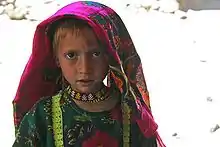
The population of the province is around 406,200 people.[43] The major ethnic group are Tajiks which make almost 50% of the population. Pashtuns (including Safis) (30%) and Pashai (17%).[1][44][45] There is also a sizable minority of Hazara and Nuristanis (ca. 3%).
Economy
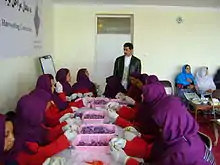
Agriculture is the largest portion of the economy. One particular crop, saffron, has been introduced as a major trade commodity in the province.
Once a week, a trade day (called a Mela) occurs. The concept of the mela is ancient, and translates to "party" in Persian, as the event is as much a social event as a trade day.
Sport
The province is represented in Afghan domestic cricket tournaments by the Kapisa Province cricket team.
Amenities
Kapisa is home to Al Biruni university, named after the Islamic scholar Alberuni who was from this region. The University offers programs in Agriculture, Engineering, Islamic Studies, Law, Medicine and Literature and is located in Kohistan district, the university was built by Ahmad Shah Massoud.
There is one hospital in the province. Previously, the province contained a textile company and cinema, which were both destroyed during the Soviet invasion of Afghanistan.
On 18 June 2012, the opening ceremony of the transformers of the power line to serve, ultimately, all of Kapisa province, was held in Mahmud-e-Raqi; where the project was launched in 2011 and funded by France. The program, at a cost of more than 10 million euros, includes the establishment of a power line that must serve the entire province. The first tranche enabled connects Mahmud-e-Raqi, the provincial capital, the hydroelectric dam Naghlu Surobi, south of Kapisa. Eventually, the program will allow 40,000 Afghans to enjoy electricity in their homes in addition to serving the public infrastructure: schools, mosques, health centers. This project is being conducted by the French brigade La Fayette and the Foreign Ministry of France.
See also
Footnotes
- "Afghanistan's Provinces - Kapisa" (PDF). nps.edu.
- "Afghanistan Provinces". Statoids.com. Retrieved 2013-05-02.
- Ashtadhyayia Sutra IV.2.99.
- Wahab, Shaista; Youngerman, Barry (2007). A Brief History of Afghanistan. Facts on File. p. 46. ISBN 978-0-8160-5761-0.
- Sutra IV.2.29.
- Dr S. Chattopadhyaya 1974: 58; India as Known to Panini, 1953, p. 71, Dr V. S. Aggarwala; Foreign Elements in Ancient Indian Society, 2nd Century BC to 7th Century AD, 1979, p. 86, Dr Uma Prasad Thapliyal.
- See: Notes on Indian coins and Seals, Part IV, E. J. Rapson in Journal of the Royal Asiatic Society of Great Britain & Ireland, 1905, p 784, (Royal Asiatic Society of Great Britain and Ireland).
- A Grammatical Dictionary of Sanskrit (Vedic): 700 Complete Reviews of the Best Books for ..., 1953, p 118, Dr Peggy Melcher, Vasudeva Sharana Agrawala, Surya Kanta, Jacob Wackernagel, Arthur Anthony Macdonell.
- Cultural History of Ancient India: A Socio-economic and Religio-cultural Survey of Kapisa and ... , 1979, p 29, Jaya Goswami; India as Known to Pāṇini: A Study of the Cultural Material in the Ashṭādhyāyī, 1953, 118, Dr Vasudeva Sharana Agrawala
- Mahabharata 2.48.7.; Tribes in the Mahabharata: A Socio-cultural Study, 1987, pp. 94 ,314, Krishna Chandra Mishra - Mahābhārata; Geographical and Economic Studies in the Mahābhārata: Upāyana Parva, 1945, p. 44, Dr Moti Chandra - India
- Su-kao-seng-chaun, Chapter 2, (no. 1493); Kai-yuan-lu, chapter 7; Publications, 1904, pp. 122–123, published by Oriental Translation Fund (Editors Dr T. W. Rhys Davis, S. W. Bushel, London, Royal Asiatic Society).
- Dupree, Nancy Hatch; Kuhzād, Aḥmad ʻAlī (1972). "An Historical Guide to Kabul - The Name". American International School of Kabul. Archived from the original on 2010-08-30. Retrieved 2010-09-18.
- Historiarum Philippicarum libri XLIV, XV.4.19
- Puri, Baij Nath (1987). Buddhism in central Asia. Motilal Banarsidass. p. 352. ISBN 81-208-0372-8. Retrieved 2010-11-03.
- "ISAF - International Security Assistance Force". Isaf.nato.int. Archived from the original on 2013-04-29. Retrieved 2013-05-02.
- Matlack, Carol (2012-06-09). "France Confirms Afghanistan Troop Withdrawal Plan, AFP Reports". Bloomberg. Retrieved 2013-05-02.
- "US shutting down PRT's in Afghanistan". wadsam.com. 2012-10-22. Retrieved 2014-05-07.
- "DVIDS - News - PRT Kapisa works toward legacy of sustainment". Dvidshub.net. Retrieved 2013-05-02.
- Allen, Peter (2008-08-19). "10 French soldiers killed by the Taliban in Afghanistan". Telegraph. London. Retrieved 2013-05-02.
- "French troops died after Italy stopped bribing local Taliban, Times reports - AFGHANISTAN". FRANCE 24. Archived from the original on 2012-07-24. Retrieved 2013-05-02.
- "In Alasay Valley, the Fight Continues —". Registan.net. 2009-04-09. Retrieved 2013-05-02.
- Foust, Joshua (2010-01-28). "Checking Up on Kapisa —". Registan.net. Retrieved 2013-05-02.
- "Afghanistan government corruption remains despite President Karzai's pledge to root out graft probes". NY Daily News. Associated Press. 2011-10-11. Retrieved 2014-05-07.
- al Habib, Maria (2012-04-01). "U.S. Blames Senior Afghan in Deaths". Wall Street Journal. Retrieved 2014-05-07.
- "Talibanistan". National Geographic. 2011-07-01. Retrieved 2014-05-07 – via YouTube.
- Foust, Joshua (2010-02-07). "Possibly, Kapisa Insurgent Figure Detained —". Registan.net. Retrieved 2013-05-02.
- Rubin, Alissa J. (2010-10-13). "French General Mixes Formula for a Bit of Afghan Calm". The New York Times.
- Miglani, Sanjeev (2012-06-09). "Veiled suicide bomber kills four French soldiers in Afghanistan". Reuters. Retrieved 2013-05-02.
- "AFP: French minister in Afghanistan after deaths". Google.com. 2012-06-10. Retrieved 2013-05-02.
- Sarwary, Bilal (2012-04-16). "BBC News - Analysis: What Kabul attacks say about Afghan security". Bbc.co.uk. Retrieved 2013-05-02.
- "What Happens When French Troops Leave Afghanistan? - All News Is Global". Worldcrunch.com. Archived from the original on 2012-06-25. Retrieved 2013-05-02.
- "How France lost Afghanistan | Need to Know". PBS. 2012-06-15. Retrieved 2013-05-02.
- http://www.nps.edu/programs/ccs/Docs/PDF%20Maps/kapisa%20land%20cover.pdf
- Ephron, Dan (July 13, 2007). "The Government Cannot Deliver". e-Ariana. Ariana Media. Newsweek. Archived from the original on February 17, 2012. Retrieved 2013-05-02.
- "South Asia | Afghan governor removed from post". BBC News. 2007-07-16. Retrieved 2013-05-02.
- Archived May 16, 2008, at the Wayback Machine
- Rubin, Alissa J. "Taliban Militants Fire Rockets on Crowded Bazaar Northeast of Kabul". Afghanemb-canada.net.
- "Kapisa | 2010 Wolesi Jirga Elections". 2010.afghanistanelectiondata.org. 2010-11-24. Archived from the original on 2014-03-06. Retrieved 2013-05-02.
- Archive, Civil Military Fusion Centre Archived May 31, 2014, at the Wayback Machine
- Ross, Andrew. "Afghanistan Geographic & Thematic Layers". Fao.org. Retrieved 2013-05-02.
- AREU "The Afghan Research Newsletter" Issue 25. April/May 2010
- Kapisa – Provincial ProfileArchived March 21, 2012, at the Wayback Machine National Area-Based Development Programme (NABDP), Government of Afghanistan,
- "Kapisa Province: A COIN Case Study in Afghanistan". Scribd.com. Retrieved 2013-05-02.
Further reading
External links
![]() Media related to Kapisa Province at Wikimedia Commons
Media related to Kapisa Province at Wikimedia Commons

